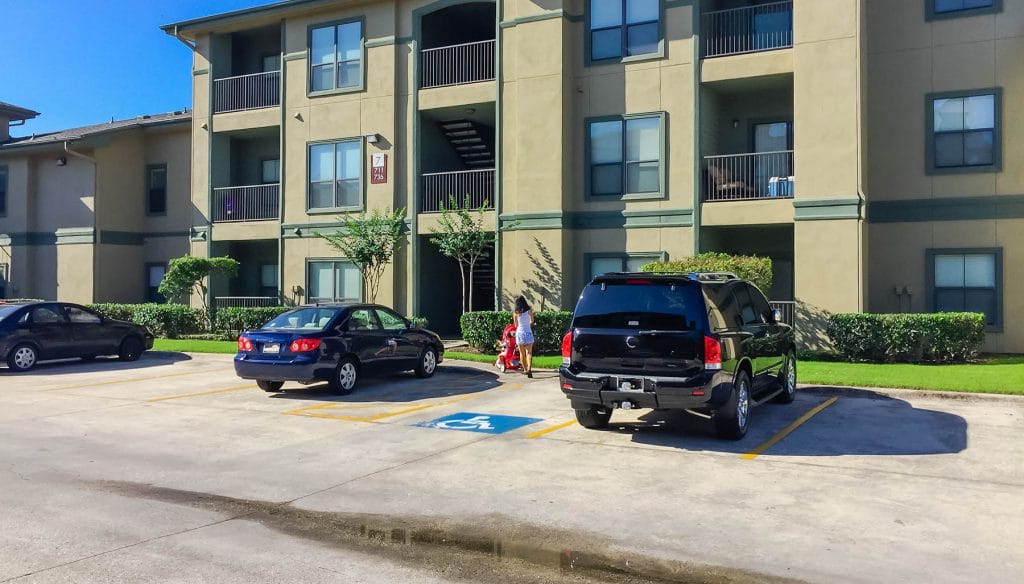
If you own or operate a business property, understanding how the Americans with Disabilities Act (ADA) impacts accessible parking provision for your visitors is essential.
The ADA is a federal law designed to protect the rights of Americans with disabilities by prohibiting discrimination and guaranteeing equal opportunities for people with disabilities. It is split into different sections:
Employment (Title I)
Public Services (Title II)
Public Accommodations (Title III)
Telecommunication (Title IV)
Misc. (Title V)
As a federal law, the ADA applies to all local, county, state, and federal government agencies as well as many businesses in the United States with 15 or more employees who are open to the public including hotels, retail stores, restaurants, medical facilities, private schools, and health clubs.
Accessible parking comes mainly under Title III which prohibits any government agency or commercial entity from discriminating against individuals with disabilities by not providing equal opportunities to access their commercial facility and utilize it in the way it was intended.
Commercial buildings built before 1990 are subject to different regulations where barriers should be removed when readily achievable – in most cases changing parking lot layouts will be achievable this requires implementation. Different counties or cities may have their local building codes that specify additional requirements that go beyond the ADA.

In practice
For a parking lot, garage, or building to be considered ADA compliant, the business must provide unobstructed access to and from accessible parking spaces to all accessible elements and spaces, such as walks, sidewalks, curb ramps and pedestrian ramps, lobbies and corridors, elevators, and sanitary facilities.
Parking bays must be appropriately marked out, signage installed, and clear directions to space(s) from the entrance. One of the biggest issues with parking is that markings fade over time. Bays must be marked, and a repainting program initiated depending on weather conditions and erosion within your parking lot.
The color of the striping used on the pavement is not dictated by accessibility regulations in the ADA but the color used must contrast with the pavement color. Blue is typically used. Other colors may be used depending on local or state regulations.
Accessible spaces must connect to the shortest accessible route to the accessible building entrance or facility they serve. If a parking facility serves multiple buildings or accessible entrances, accessible parking spaces should therefore be dispersed to enable people to park near as many accessible entrances as possible.
To ensure your parking lot meets ADA requirements, contact Direct Access for a consultation. Our total building approach ensures that all aspects of your building that relates to ADA accessibility is reviewed and considered in a detailed report that sets out recommendations in a clear action plan.
Some different States are listed here for information. We can advise on your State and the local area.
California
California has implemented its accessibility requirements in addition to the federal requirements of the ADA. California business owners need to ensure their properties are not only ADA compliant but also compliant with the California Building Standards Code (CBC).
California is also leading the way in zero-emission vehicle access with a planned 1.5m ZEVs on the road by 2025. Accessibility of charging stations is also an essential consideration.
ADA Accessible Parking Procedures
Florida
State Statue 553.5041 details that there must be one accessible parking space near a publicly owned or leased building that houses a governmental entity or a political subdivision. Including, but not limited to, state office buildings and courthouses if parking for the public is not available on the premises of the building.
Each parking space must be at least 12 feet wide. Parking access aisles must be at least 5 feet wide and be part of an accessible route to the building or facility entrance. The access aisle must be striped diagonally to designate it as a no-parking zone.
New York
In New York State, all accessible spaces must be van-accessible with an access aisle at least 8 feet wide. This rule is from the Building Code of NYS Section 1106.1.1. The code states:
Accessible parking spaces should be in conformance with ICC/ANSI A117, and these spaces should also have access aisles at least 8 feet in width.
Therefore, accessible parking spaces in New York State must be at least 8 feet wide, and all access aisles must also be at least 8 feet wide.

68 Harrison Avenue,
6th Floor,
Boston,
MA 02111.
4600 140th Avenue North,
Suite 180,
Clearwater,
FL 33762.
Explore our free guides on accessibility and inclusion, crafted by our experts. Click Here.